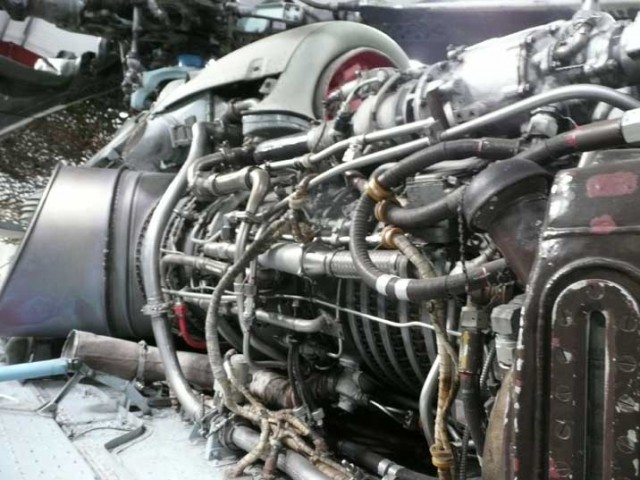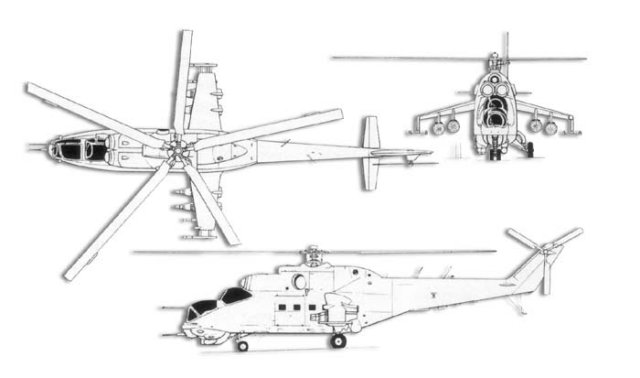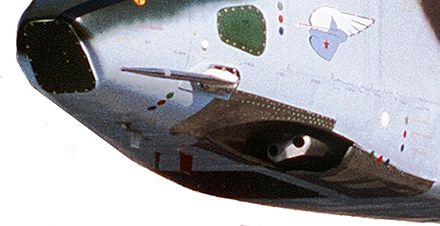The Mil Mi-24 (Russian: Миль Ми-24; NATO reporting name: Hind) is a large helicopter gunship, attack helicopter and low-capacity troop transport with room for eight passengers. It is produced by Mil Moscow Helicopter Plant and has been operated since 1972 by the Soviet Air Force and its successors, along with more than 30 other nations.
Soviet pilots called the Mi-24 the "flying tank" (летающий танк; letayushchiy tank), a term used historically with the famous World War II Soviet Il-2 Shturmovik armored ground attack aircraft.
More common unofficial nicknames were "Crocodile" (Крокодил; Krokodil), due to the helicopter's camouflage scheme and "Drinking Glass", (Стакан; Stakan) because of the flat glass plates that surround the Mi-24's cockpit.
The original model (Nato codename Hind-A), designed to carry eight combat troops, was later reconfigured to take on the gunship role (Hind-D).
Later versions, Mi-24P and the export Mi-35P, are also armed with anti-tank missile systems for the engagement of moving armoured targets, weapon emplacements and slow-moving air targets. All versions retain the troop transport capability.
History
The Mi-24 went from drawing board in 1968 to first test-flights in less than eighteen months. The first models were delivered to the armed forces for evaluation in 1971. The Hind-A did have a number of problems: lateral roll, weapon sighting problems, and limited field of view for the pilot. A heavy redesign of the aircraft front section solved most of these problems.
The core of the aircraft was derived from the Mil Mi-8 (NATO reporting name "Hip") with two top-mounted turboshaft engines driving a mid-mounted 17.3 m five-blade main rotor and a three-blade tail rotor. The engine configuration gave the aircraft its distinctive double air intake. Original versions have an angular greenhouse-style cockpit; Model D and later have a characteristic tandem cockpit with a "double bubble" canopy. Other airframe components came from the Mi-14 "Haze". Two mid-mounted stub wings provide weapon hardpoints, each offering three stations, in addition to providing lift. The loadout mix is mission dependent; Mi-24s can be tasked with close air support, anti-tank operations, or aerial combat.
It has retractable tricycle nose-wheel landing gear to reduce drag. At high speed, the wings provide considerable lift (up to a quarter of total lift). The main rotor was tilted 2.5° to the right from the fuselage to compensate for translating tendency at a hover. The landing gear was also tilted to the left so that the rotor would still be level when the aircraft was on the ground, making the rest of the airframe tilt to the left. The tail was also asymmetrical to give a side force at speed, thus unloading the tail rotor. The two crew (pilot and weapons operator) are accommodated in tandem armoured cockpits with individual canopies and flat, bulletproof glass windscreens. The main cabin can accommodate eight troops or four stretchers.
The Mi-24 fuselage is heavily armored and can resist impacts from 12.7 mm (0.50 in) rounds from all angles. The titanium rotor blades are also resistant to 12.7 mm rounds. The cockpit is protected by ballistic-resistant windscreens and a titanium-armored tub. The cockpit and crew compartment are overpressurized to protect the crew in NBC conditions.
Weapons
The helicopter has six suspension weapon units on the wingtips. The Mi24D (Mi-25) and the Mi-24V (Mi-35) are equipped with a YakB four-barrelled, 12.7mm, built-in, flexibly mounted machine gun, which has a firing rate of 4,000-4,500 rounds a minute and a muzzle velocity of 860m/s. The Mi-24P is fitted with a 30mm, built-in, fixed gun mount; the Mi-24VP with a 23mm, built-in, flexibly mounted gun.
The Mi-24P and Mi-24V have four underwing pylons for up to 12 anti-tank missiles. The Mi-24V (Mi-35) is armed with the Shturm anti-tank guided missile system. Shturm (Nato designation AT-6 Spiral) is a short-range missile with semi-automatic radio command guidance. The 5.4kg high-explosive fragmentation warhead is capable of penetrating up to 650mm of armour. Maximum range is 5km.
The Mi-24V can also carry the longer-range Ataka anti-tank missile system (Nato designation AT-9), as can the Mi-24P. The Ataka missile's guidance is by narrow radar beam, and the maximum range of the missile is 8km. The average target range is between 3km-6km. The target hit probability of the Ataka missile is higher than 0.96 at ranges 3km-6km. The missile has a shaped-charge 7.4kg warhead, with a tandem charge for penetration of 800mm-thick explosive reactive armour.
All Mi-24 helicopters can also be armed with rockets and grenade launchers.
Avionics
The Mi-24D is equipped with the KPS-53A electro-optical sighting pod. The most recent Mi-24V and P variants have a digital PNK-24 avionics suite and multifunction LCD cockpit displays, and Geofizika ONV1 night-vision goggles, along with NVG-compatible cockpit lighting. They are fitted with the Urals Optical and Mechanical Plant GOES-342 TV/FLIR sighting system and a laser rangefinder. Countermeasures include infrared jammer, radar warner and flare dispensers.
Engines
The helicopter is powered by two Isotov TV3-117VMA turboshaft engines, developing 2,200shp each (1,600 kw). The air intakes are fitted with deflectors and separators to prevent dust particle ingestion when taking off from unprepared sites. An auxiliary power unit is fitted.
The internal fuel capacity is 1,500kg, with an additional 1,000kg in an auxiliary tank in the cabin or 1,200kg on four external tanks. The fuel tank has self-sealing covers and porous fuel tank filler for increased survivability, and the exhaust is fitted with infrared suppression systems. The tail rotor control rods were spaced wider apart to stop them from being shot away by a single round.
List of variants
A-10
Designation given to the aircraft used for record breaking from 1975 in The FAI E1 class.
V-24
The first version, twelve prototypes and development aircraft. The first V-24 mockup resembled the Bell UH-1A Huey. Later models resembled the future Hind-A, one of which was modified in 1975 as A-10 for speed record attempts with wings removed and faired over and with inertia-type dampers on the main rotor head. The A-10 reached a speed of 368 km/h.
Mi-24
(Hind-A) Other early versions were the armed assault helicopter, which could carry eight combat troops and three crew members. It could also carry four 57mm rocket pods on four underwing pylons, four MCLOS 9M17 Fleyta (AT-2 Swatter) anti-tank missiles on two underwing rails, free-fall bombs, plus one Afanasev A-12.7 12.7mm machine-gun in the nose. The Mi-24 was the first production model.
Mi-24B
(Hind-A) Experimental series of Hind-A, one of which was used to test the Fenestron tail rotor.
Mi-24F
(Hind-A) Modified Hind-A with seven reinforcing ribs on the port fuselage aft of the wing and the SRO-2M Khrom ("Odd Rods") IFF antenna relocated from the canopy to the oil cooler. The APU exhaust was also extended and angled downwards. The designation may be unofficial.
Mi-24A
(Hind-B) The Mi-24A was the second production model. Both the Mi-24 and Mi-24A entered Soviet Air Force service in 1972. Lacks the four-barrel Yak-B 12.7mm machine gun under the nose.
Mi-24U
(Hind-C) Training version without nose gun and wingtip stations.
Mi-24BMT
Small number of Mi-24s converted into minesweepers.
Mi-24D
(Hind-D) The Mi-24D was a purer gunship than the earlier variants. It entered production in 1973. The Mi-24D has a redesigned forward fuselage, with two separate cockpits for the pilot and gunner. It is armed with a single 12.7mm four-barrel Yak-B machine-gun under the nose. It can carry four 57mm rocket pods, four SACLOS 9M17 Phalanga anti-tank missiles (a significant enhancement compared to the MCLOS system found on the Mi-24A), plus bombs and other weapons. One Mi-24D was sold to Poland in January 1996 and was used by the WTD 61 in Manching during 1994 for tests with the head of a Hawk missile in place of the chin-mounted gun. This version also had an unidentified modification in the rear cabin window on the starboard side.
Mi-24PTRK
This version was the Mi-24D modification that was used for testing the Shturm V missile system for the Mi-24V.
Mi-24DU
Small numbers of Mi-24Ds were built as training helicopters with doubled controls.
Mi-24V
(Hind-E) Later development led to the Mi-24V which entered production in 1976 and was first seen by the west in the early 1980s. It was armed with the more advanced 9M114 Shturm (AT-6 Spiral). Eight of those missile are mounted on four outer wing pylons. It was the most widely produced version with more than 1,500 made. In Polish service this aircraft is designated Mi-24W. One Mi-24V was referred to as Mi-24T for unknown reasons.
Arsenal Mi-24V upgrade
Ukrainian upgrade for Mi-24V
Mi-24P
(Hind-F) The gunship version, which replaced the 12.7mm machine-gun with a fixed side-mounted 30mm GSh-30K twin-barrel cannon.
Mi-24TECh-24
"Mobile Repair Shop" Experimental Hind-F to test abilities for recovery of downed aircraft.
Mi-24VP
(Hind-E Mod) Development of Mi-24V made in 1985 which replaced the machine-gun with twin 23mm cannons in a movable turret. Entered service in 1989, but only 25 were made before production ended the same year. One Mi-24VP flew with the Delta-H tail rotor of the Mi-28.
Mi-24VU
(Hind-E) Indian training version of Mi-24V "Hind-E".
Mi-24VD
This version was produced in 1985 to test a rear defensive gun.
Mi-24RKhR
(Hind-G1) NBC reconnaissance model, which is designed to collect radiation, biological and chemical samples. It was first seen during the 1986 Chernobyl nuclear disaster. Also known as the Mi-24R, Mi-24RK and Mi-24RKh (Rch).
Mi-24RA
(Hind-G1 Mod) New version of the Mi-24V.
Mi-24RR
Radiation reconnaissance model derived from the Mi-24R.
Mi-24K
(Hind-G2) Army reconnaissance, artillery observation helicopter.
Mi-24M
Proposed naval version, unbuilt.
Mi-24VM
upgraded Mi-24V with updated avionics to improve night-time operation, new communications gear, shorter and lighter wings, and updated weapon systems to include support for the Ataka, Shturm and Igla-V missiles and a 23mm main gun. Other internal changes have been made to increase the aircraft life-cycle and ease maintenance. The Mi-24VM is expected to operate until 2015.
Mi-24VN
(Hind-E) (Mi-35O "Hind-E") A night-attack version based on an Mi-24V in Mi-24VM Stage 1 configuration.
Mi-24PM
Upgraded Mi-24P using same technologies as in Mi-24VM.
Mi-24PN
The Russian military has selected this upgraded Mi-24 to be their primary attack helicopter. The PN version has a TV and a FLIR camera located in a dome on the front of the aircraft. Other modifications include using the rotor blades and wings from the Mi-28 and fixed rather than retractable landing gear. The Russians received 14 Mi-24PNs in 2004 and plan on eventually upgrading all of their Mi-24s.
Mi-24PS
Civil police or paramilitary version, equipped with a FLIR, searchlight, loudspeaker PA system and attachments for rappelling ropes.
Mi-24V Ecological Survey Version
Environmental research modification developed by the Polyot Industrial Research Organisation.
Mi-25
The export version of the Mi-24D.
Mi-35
The export version of the Mi-24V.
Mi-35M
Night attack version, is fitted with upgraded advanced avionics and sensor package, including night vision systems, GOES-342 electro-optical range finder/targeting system, GLONASS/GPS navigation system, electronic multifunction displays, onboard computer, and jam-proof communications equipment. Also known as Mi-35M1.
Mi-35MS
Flying Comandopost variant of Mi-35M
Mi-35M2
Updated version of the Mi-35M for the Venezuelan Army.
Mi-35M3
Export Mi-24VM.
Mi-35M4
(AH-2 Sabre) Updated version of the Mi-35M with Israeli avionics for the Brazilian Airforce.
Mi-35O
Export version of the Mi-24VN using a Mexican FLIR camera and a glass cockpit with upgraded avionics. Operated by Mexico only.
Mi-35P
The export version of the Mi-24P.
Mi-35U
Unarmed training version of the Mi-35.
Mi-24 SuperHind Mk.II
Modern western avionics upgrade produced by South African company Advanced Technologies and Engineering (ATE). Prototypes converted from Mi-24R models, and one Mi-24P was used to test sighting system.
Mi-24 SuperHind Mk.III
Extensive operational upgrade of the original Mi-24 including weapons, avionics and counter measures.
Mi-24 SuperHind Mk.IV
Upgraded Mk. III version with Pall vortex engine air particle separator system over the engine intakes.
Mi-24 SuperHind Mk.V
Newest version of the "SuperHind" with fully redesigned front fuselage and cockpit.
Mi-24 Afghanistan field modifications
Passenger compartment armour and exhaust suppressors were often removed. Due to accidental firing while switching sides, the door gunner was given both a port and starboard gun. Extra rounds for the rocket pods to allow self-reloading near the battlefield and also heavy weapons for self-defense were often carried.
Tamam Mi-24 HMOSP
Israeli upgrade.
Mi-PSV
experimental helicopter based on the Mil Mi-24 (PSV stands for Perspektivny skorostnoi vertolet (Перспективный скоростной вертолёт) - prospective (promising) high speed helicopter). Single-seat streamlined cockpit, unarmed, fitted with experimental main rotors for research into high-speed flight, with a target of increasing the speed of the Mil Mi-28N by 10% and the Mil Mi-35M by 13%.
Specifications (Mi-24)
This section needs additional citations for verification.
Data from Indian-Military.org
General characteristics
Crew: 2–3: pilot, weapons system officer and technician (optional)
Capacity: 8 troops or 4 stretchers or 2400 kg (5,291 lb) cargo on an external sling
Length: 17.5 m (57 ft 4 in)
Rotor diameter: 17.3 m (56 ft 7 in)
Wingspan: 6.5 m (21 ft 3 in)
Height: 6.5 m (21 ft 3 in)
Disc area: 235 m2 (2,530 ft2)
Empty weight: 8,500 kg (18,740 lb)
Max. takeoff weight: 12,000 kg (26,500 lb)
Powerplant: 2 × Isotov TV3-117 turbines, 1,600 kW (2,200 hp) each
Performance
Maximum speed: 335 km/h (208 mph)
Range: 450 km (280 miles)
Service ceiling: 4,900 m (16076 ft).
Armament
Internal guns
- flexible 12.7 mm Yakushev-Borzov Yak-B Gatling gun on most variants. Maximum of 1,470 rounds of ammunition.
- fixed twin-barrel GSh-30K on the Mi-24P. 750 rounds of ammunition.
- flexible twin-barrel Gryazev-Shipunov GSh-23L on the Mi-24VP and Mi-24VM. 450 rounds of ammunition.
- PKB passenger compartment window mounted machine guns
External stores
- Total payload is 1,500 kg of external stores.
- Inner hardpoints can carry at least 500 kg
- Outer hardpoints can carry up to 250 kg
- Wing-tip pylons can only carry the 9M17 Phalanga (in the Mi-24A-D) or the 9K114 Shturm complex (in the Mi-24V-F).
Bomb-load
- Bombs within weight range (presumably ZAB, FAB, RBK, ODAB etc.), Up to 500 kg.
- MBD multiple ejector racks (presumably MBD-4 with 4 × FAB-100)
- KGMU2V submunition/mine dispenser pods
First-generation armament (standard production Mi-24D)
- GUV-8700 gunpod (with a 12.7 mm Yak-B + 2 × 7.62 mm GShG-7.62 mm combination or one 30 mm AGS-17)
- UB-32 S-5 rocket launchers
- S-24 240 mm rocket
- 9M17 Fleyta (a pair on each wingtip pylon)
Second-generation armament (Mi-24V, Mi-24P and most upgraded Mi-24D)
- UPK-23-250 gunpod carrying the GSh-23L
- B-8V20 a lightweight long tubed helicopter version of the S-8 rocket launcher
- 9K114 Shturm in pairs on the outer and wingtip pylons






.jpg/1024px-Mi-24D_Hind_Attack_Helicopter_(Berlin).jpg)



